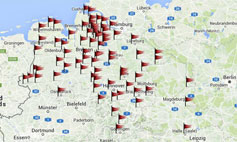Chromatography in foodstuffs testing
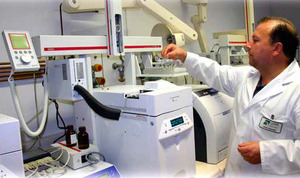
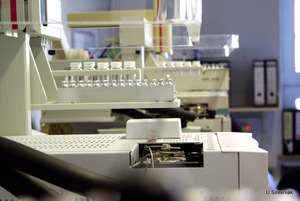
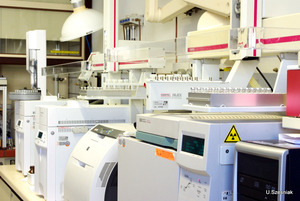
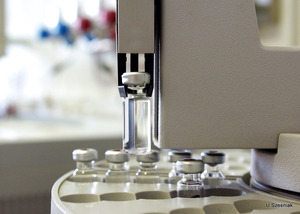
Chromatography, residue analysis and immunology
The range of analyses includes testing of milk, dairy products, meat, sausage products, ready meals, delicacies, fish, coffee, cocoa, chocolate, pastries, herbs, spices and drinks.
Among other equipment, we employ High Performance Liquid Chromatography (HPLC) that can be fitted out with specific and therefore extremely sensitive detectors, thus being able to detect Aflatoxin M1 in the nanogram range (10-9).
HPLC—spectrum of analysis (Institute for Food Quality):
-
Mycotoxins (e.g. Aflatoxin M1 and Ochratoxin)
-
preservatives (e.g. sorbic acid and benzoic acid)
-
sugar spectrum (glucose, fructose, saccharose, maltose, lactose)
-
glycomacropeptide (rennet whey detection)
-
whey protein (e.g. lactoglobuline and albumin)
-
caffeine and theobromine
-
vitamins
-
natamycin
However, at the center of our analysis facilities is Gas Chromatography (GC) with focus on pesticides and fatty acid analyses in just about all imaginable feed/food matrices. A complex extraction and clean-up system provide extremely clean samples with system cooling to ensure that analysis results comfortably fulfil regulatory stipulations.
GC—spectrum of analysis (Institute for Food Quality)
-
pesticides and PCBs (polychlorinated biphenyl)
-
fatty-acid spectrum
-
lactic acid determination with butyric acid C4
-
volatile halogenated hydrocarbons (CHC) especially trichloromethane (chloroform)
-
cholesterol and phytosterols
Our expertise in the analysis of residues—especially in the area of dairy products and foodstuffs—has lead to us initiating numerous investigation programs, which have been carried out in collaboration with the 'Landesvereinigung der Milchwirtschaft' (Regional Dairy Association) or with dairies. End-to-end dairy residue monitoring is implemented from the dairy plants, bulk tankers down to individual milk suppliers. In this way, residues can be determined in raw milk, thus ensuring that early detection protects later production stages.
Comprehensive and regular sampling takes place during collection from suppliers, where individual samples are pooled. Predefined thresholds, which are set to levels well below legally permitted levels, are used as warning indicators. If thresholds are overstepped, the individual samples in respective pools are taken for closer analysis.
If this process registers that residue levels overstep permitted levels, respective suppliers are taken out of the supply chain until the situation is resolved. Unwanted residues can enter the supply chain through contaminated feedstuffs or cleaning agents, which enter a dairy cow's organism. If necessary, all relevant feedstuffs are tested and advice is provided with respect to the optimisation of milking equipment and cleaning cycles.
milk monitoring
-
pesticides
-
PCBs (polychlorinated biphenyl)
-
Aflatoxin M1
-
trichloromethane (cleaning agent determination)
-
veterinary medicinal products and inhibitors
If necessary, the running programs can be augmented by special testing, such as:
-
dioxins and dl-PCB (dioxin-like PCB)
-
heavy metals (Pb, Cd, Hg, and As)
-
hormones
-
radioactivity
In the scope of this residue monitoring, some 3,000 milk samples have been tested by the Institute for Food Quality. Many hundred follow-up samples have also been tested in order to ensure that any possible contamination is identified as soon as possible.




 Point of contact
Point of contact

Holters, Marina
Laboratory manager ChromatographyAmmerländer Heerstr. 115 - 117
26129 Oldenburg
Germany
Phone: +49 441 97352-184
E-Mail: Marina.Holters~lufa-nord-west.de






